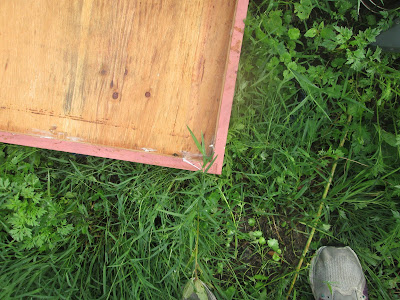We are not planning to harvest from this hive this year. Starting so late, our best hope is that the bees can collect enough honey to make it through the winter.
There were plenty of bees coming in and out of the hive, but also asparagus greenery in front of the hive so it's hard to see any bees in this photo - trust me, they were there!
The first thing I did was to kill a black widow spider who had built her web and laid eggs inside the top cover. I frequently have found black widows in the inside of the top cover - this is at least the fifth one in the last two years. (You can't see her in the photo but can see the remnants of her web.
Upon opening the hive, I found beautiful straight comb and the bees were making good use of what they had. In this comb they were storing nectar:
In these two shots the honeycomb is full of eggs - just look at how active this good queen is!
Since I live over 100 miles from this hive, I decided to leave them with a fourth box even though they had barely started using the third box. It is the height of the sourwood flow and if they don't use the box for nectar, it will help with ventilation. I did not put a ladder frame into the hive because there wasn't one available in the box below, so we'll just hope for the best.
 Truly my car was not parked on top of the hive, but it does look rather strange! I'll be back in a few weeks to check on this hive and probably to steal one frame of sourwood honey!
Truly my car was not parked on top of the hive, but it does look rather strange! I'll be back in a few weeks to check on this hive and probably to steal one frame of sourwood honey!
As I drove back to the mountain house, I was struck by the beauty of the roadside blooming weeds that serve the bees so well in the country. There was an abundance of Queen Anne's lace, bright orange butterfly weed (a member of the milkweed family which bees love), and black-eyed Susans.
Aren't they lovely? The sad thing for bees today is that when you aren't in the country as I am now, the sides of the road are not full of flowering weeds.








No comments:
Post a Comment